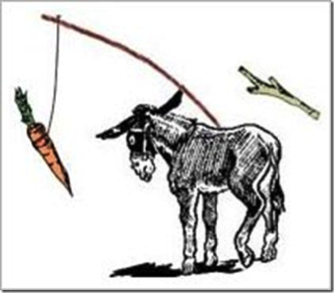
There was a time when rewards and punishments were the foundation of most parents’ efforts to discipline their children. The formula was pretty simple - reward positive, pro-social, compliant behavior with some sort of “carrot” or reinforcement; and punish inappropriate, anti-social, and non-compliant behavior with a negative consequence.
The more enlightened forms of this basic approach included caveats such as “catch them being good” to highlight the importance of focusing on opportunities to reward or reinforce positive behavior rather than interacting in a “parental” way primarily when the child misbehaved. In fact, many authorities in the field of behavior modification recommended at least four positive interactions for every one negative parent-child interaction.
They did this based on research that suggested that the long term effects of negative interactions (especially angry, disapproving looks and actions) could do more harm than good. For instance, it is possible for some children to become convinced (consciously or unconsciously) that the only way they are going to get attention from their parent(s) is to misbehave! In such cases, the well-intentioned efforts to improve the child’s behavior patterns actually end up worsening them. Children MUST have attention and will get it one way or another. Some children become so discouraged by parents who only focus on their “bad” behavior that they simply give up on trying to please them. It is as if they come to believe, “If I can’t be your best child, I’ll be your best worst child.”
Now, however, our knowledge base in regard to managing troubling behavior has evolved far beyond the old “carrot and stick”. The leading edge approach to dealing with patterns of misbehavior is to do a Functional Analysis of Behavior which then leads to a Positive Behavior Support Plan.
Now, do not let those fancy, psychobabble terms scare you off. It is actually as simple as A-B-C. But, we will get to that in a moment. First, it is important to know that the “evolution” of our approaches to managing challenging behavior has come about as a result of a “revolution” in our thinking about the underlying causes of the behavior.
The “old school” way of thinking was a “surface” approach. All that it required was systematically attending to observable behavior and then reacting with either a positive or negative consequence. And then, if done right, data was taken to determine whether or not the pattern of behavior had changed from “baseline” levels. That has now been replaced with a more sophisticated “depth” approach. The new - and much more effective - approach still relies on observation and data collection. However, there is a more humane motive behind the data collection.
We now know that all behavior is meaningful and that it serves some sort of “function” for the individual. In fact, what we see as misbehavior may be thought as the child’s means of communicating. That is, the child is attempting to get some important need met; and the behavior represents his or her current best guess as to how to go about it.
Research in the field of behavior management has identified four primary functions of behavior. They are easily remembered by using the acronym SEAT. The “S” stands for sensory needs. Experts working with children who demonstrate behavior disorders have found that many of them are exhibiting troublesome behavior either to obtain MORE sensory stimulation, or because they are overwhelmed by TOO MUCH sensory input. The sensory input may be visual, auditory, tactile (touch), or kinesthetic (movement).
Most parents have noted that while some children love to be hugged, squeezed, thrown up in the air, swung on swings, sung to, and delighted with all manner of intense auditory and visual stimuli; others become quite disturbed by these same sensory inputs and protest vocally or behaviorally. I’ve seen many young children cover their ears in noisy environments, resist being touched or hugged tightly; and run, screaming, from over-stimulating places like Chuck E. Cheese or McDonald’s Play Place.
Now it could be that your child is either a “sensory seeker” who craves and seeks out very stimulating people, places and activities; or a “sensory avoider” who becomes uncomfortable around certain people, in certain places, or during certain activities. I have had cases in which the parents were concerned about why a child did not love grandma. Upon analysis it turned out that the child was very sensitive to odors and chemicals and could not be around grandma’s perfume without getting a headache.
My own daughter was very sensitive to certain types of touch when she was young. For a while we had “battles” in the mornings when dressing her for school because she did not want to wear some of the cute outfits we selected for her. Initially, we thought it was a “power struggle” and that her intention was to declare her independence. Then we got wise and accepted that she was just trying to “tell us” behaviorally (because she was not yet old enough to explain it verbally) that she was uncomfortable – especially with frilly things around her neck and any tight elastic around her arms or waist (even OshKosh B'Gosh!!!). So, when we honored the “function” of her behavior (i.e., to avoid certain sensory experiences) and allowed her to simply wear loose, cotton dresses, the battles were over! They never did have to do with “power” or a “you’re not the boss of me” declaration of independence.
The “E” in SEAT stands for “escape”. Many behaviors are a child’s way of avoiding certain non-preferred people, places, or activities. I worked with a student once who was routinely getting in trouble in the classroom. After collecting some simple observational data it became obvious that the primary “pattern” was that he was acting out around 10:30 in the morning. When I interviewed him I discovered that he was very weak in math skills and “hated” that subject. Coincidentally, his teacher scheduled math instruction at around 10:30 each morning.
Once I determined that the “function” of his misbehavior was to “escape” the potential embarrassment of being identified by peers as “dumb” (his word), all I had to do was to let him know that I now understood the “communicative intent” of his misbehavior. He and I met with his teacher and parents privately. We assured him that the teacher would never call on him in class unless he raised his hand and felt confident that he knew the right answer. We arranged a “secret signal” between him and his teacher so that she would know when he was “lost” during group instruction. We arranged for him to sit near a “study buddy” (good at math) and gave them permission to talk at any time he did not understand a concept. The teacher volunteered to meet with the student before or after school to clarify concepts if he requested it. The parents decided to hire a math tutor. The disruptive behaviors went away completely!
I should mention that the teacher was delighted with this outcome. Not only because it was less stress on her than constantly halting instruction in order to deal with his disruptive behavior; but also because she felt she was being a good teacher – addressing the real, underlying cause of the behavior, rather than simply addressing the symptom with a “carrot” or a “stick”.
The “A” in SEAT refers to “attention”. I do not believe it is necessary to give examples of how far out of their way some children will go to get more attention. This is, in fact, one of the biggest “traps” that parents unintentionally fall in to. They provide units of attention to bad behavior (i.e., yelling, lecturing, warning of dire consequences, and so forth) never suspecting that, in a way, they are, inadvertently, fulfilling the child’s need for attention; and not understanding the real “function” of the child’s misbehavior.
But, let us not forget that it can work the other way also. Some children misbehave in order to avoid certain kinds of unwanted attention (think “helicopter parent”). Although the “function” of such behavior might properly be thought of as avoidance or “escape”, it is the opposite of acting out to get attention.
Finally, the “T” in SEAT stands for “tangible”. Some children misbehave in order to obtain (or get access to) certain things. Again, specific examples are not necessary because parents deal with children’s demands for certain foods, toys, electronic screens, etc. all the time. The only trick to be mastered here is to NOT routinely pay off misbehavior by giving in and providing (or allowing access to) the desired “stuff”. Rather, any access to preferred objects or activities should be granted AS A RESULT OF (or contingent upon) positive behavior. I know…it takes a lot of practice to master this one!
So, how do we do a simple “functional analysis” in our efforts to understand what the behavior is telling us – what needs the child is trying to fill while engaging in the persistent pattern of unwanted behavior? As noted above, it is as simple as A-B-C.
“A” stands for “antecedents”. That is just a fancy way of paying close attention to what is happening JUST BEFORE the undesirable behavior occurs. The antecedents (also called “setting events”) may include the time of day, the place, the number of people present, exactly who is present, whether or not the child is hungry, whether or not the child is tired, and so forth.
“B” stands for the observable “behavior”. When doing a functional analysis, it is important to be very specific when defining the behavior that you want to understand. For instance, it is easy to keep track – on a simple data sheet – of how many times per day (on average) little Johnny hit his sister. It is not at all easy to document how frequently little Johnny was angry, or felt frustrated, or was jealous. Thoughts and feelings are not observable.
The “C” stands for “consequences”. What we are attending to here is what happened DIRECTLY AFTER the undesired behavior occurred. As a result (or consequence) of the behavior did the child end up getting a certain need met? Did the child get get more (or less) sensory input? Did the child manage to escape some non-preferred activity, expectation, or responsibility such as homework, chores, etc.? Did the child manage to get a lot of attention from one or more adults, from one or more siblings, from one or more friends or classmates, from someone online? Did the child end up with a preferred toy or access to a preferred activity?
When the antecedents and consequences are diligently observed over a period of time it will generally clarify what the function of the behavior is. The next step is to determine whether to use a “proactive” approach, a “reactive” approach, or both.
A proactive approach focuses on the antecedents. This simply means that we try to prevent the behavior from occurring at all by changing the “setting events” that typically precede the behavior. If, for instance, we have learned that the child is becoming over stimulated with too much sensory input from using a particular screen device (e.g., iPad, DS, Wii, video games, smart phone, computer, etc.), then the proactive approach is to develop a working family agreement regarding how much time is spent using the device(s), and when, and where. The agreement would include attractive alternatives to screen time from which the child may choose.
You see, the child is not misbehaving on purpose in order to ruin your day. The child just communicates - with behavior - that he or she cannot, at this age, handle that much sensory input. The function of the behavior is to let you know that. This behavior should not be “punished” (verbally, physically or otherwise), it should be understood and “managed”.
A reactive approach focuses on the consequences of the behavior. This means that we try to DO SOMETHING DIFFERENT after the behavior occurs in order to prevent it from being inadvertently rewarded or reinforced. For example, let's say that you set a limit on the amount of screen time your child is allowed. And, let’s say that every time you enforce that limitation the child has a tantrum. In the past you would start out having what you thought was a reasonable discussion of why you are limiting access to the screen(s). But, your “reasonable discussion” almost always devolved into push-back, a heated argument, and a tantrum which you could not ignore. This led to you upping the ante and yelling, lecturing, warning of dire consequences. Later on you felt guilty and ashamed of yourself for “losing it” with your child and gave some sort of compensatory love, attention or affection.
Now you realize that your child was getting A LOT of attention as a result of challenging your limits. In addition, it occasionally paid off because, due to circumstances not entirely in your control, you gave in and allowed more time on the device. So, on those occasions your child got a tangible reward for throwing the tantrum.
A better reactive strategy would be to simply SAY WHAT YOU MEAN, MEAN WHAT YOU SAY, AND DO WHAT YOU SAY YOU ARE GOING TO DO with consistency. That is, you show up at the end of the allotted time, give the child a directive to disconnect from the screen, remind the child of the preplanned alternatives to screen time for having fun, and remain firm without discussion, arguing or giving. You would ignore the tantrum by letting it run its course without having the intended effect, and either leave the child’s presence, preferably taking the device with you. In this way the child does not get a “fix” of negative attention and does not get a tangible reward for having a tantrum. After doing this several times the child will “get it” that you are strong enough to say what you mean, mean what you say, and do what you say you are going to do. THE TANTRUMS WILL STOP! After all, they are not working, and children quickly abandon behaviors that do not serve the function of satisfying their needs.
To summarize, keeping a simple A-B-C chart can lead to understanding the communicative function of the undesired behavior. Once you understand what the child is “communicating”; what need is being met (in a somewhat immature way), you can then get creative with proactive and reactive strategies that empower you as a parent; and get you out of the business of handing out carrots and waving sticks.



























